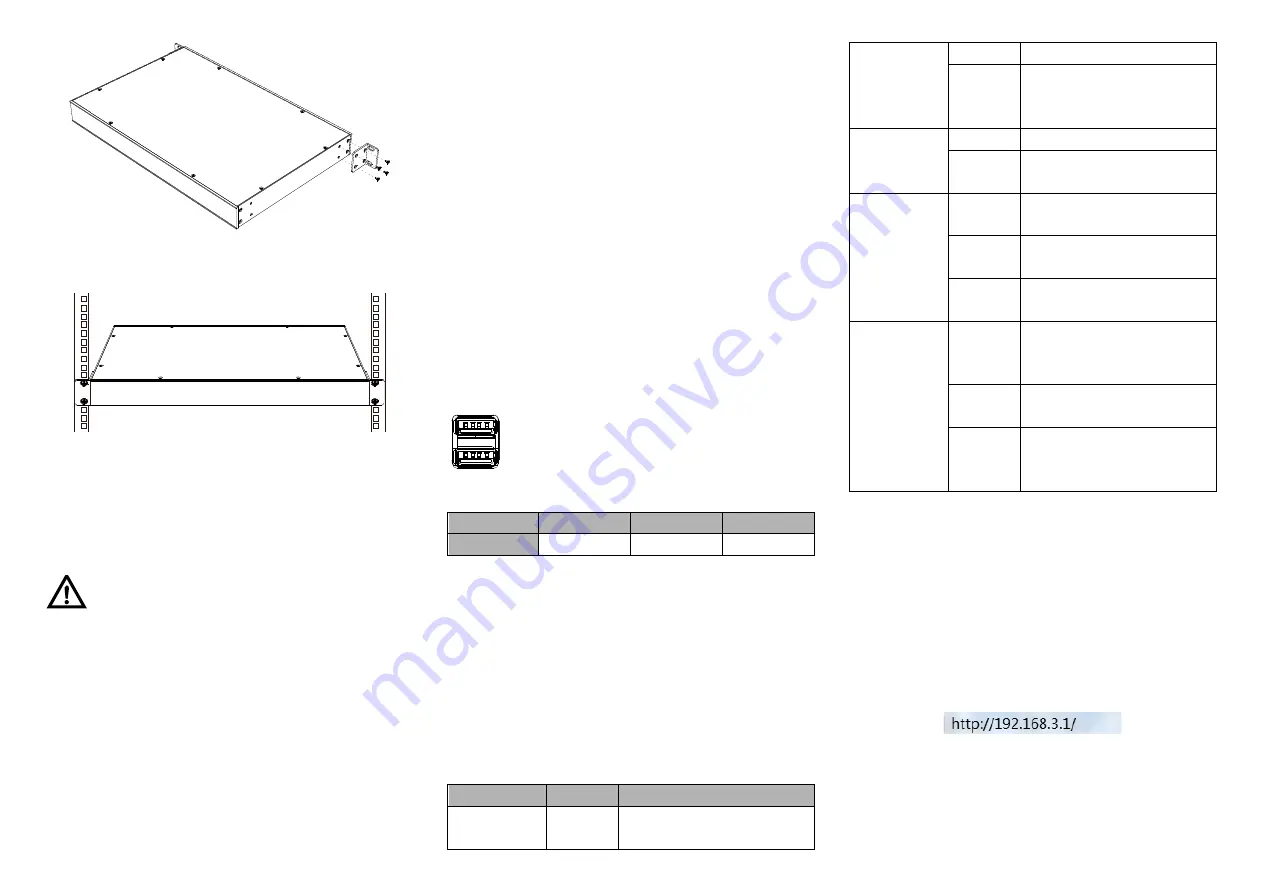
Step 3
Place the device on the rack surface plate; adopt 4
screws to mount the right and left mounting lugs on
the rack.
Step 4
Check and confirm the product is mounted firmly on
the rack, mounting ends.
【
Disassembling Device
】
Step 1
Device power off.
Step 2
Unscrew the fixed mounting lug screw on the rack.
Step 3
Shift out the device from rack, disassembling ends.
Note before powering on:
Power ON operation: First insert the power supply
terminal block into the device power supply interface,
and then plug the power supply plug contact and power
on.
Power OFF operation: First, remove the power plug,
and then remove the wiring section of terminal block.
Please pay attention to the above operation sequence.
【
Power Supply Connection
】
This device provides 2 AC power supply inputs, and supports
power supply redundancy. When one of the power supplies
fails, the device can still operate normally.
The power supply input range is 110~240VAC, 50~60Hz.
【
Restore factory defaults
】
RESET is restoring default settings button. Restoring default
settings steps as follows: Press and hold the RESET button
for 5s then release it, the device would restore the factory
settings automatically.
【
Relay Connection
】
Relay terminals are a set of normally open contacts of the
device alarm relay. They are open circuit in the state of normal
non alarm, closed when any alarm information occurs. For
example, they are closed when powered off, and send out
alarm. The product supports 1 relay alarm information output,
which can be connected to alarm light or alarm buzzer or
other switching value collecting devices; it can timely inform
operators when the alarm occurs.
【
Console Port Connection
】
The series products provide 1 program debugging
port based on RS-232 serial port which can
conduct device CLI command management after
connecting to PC. The interface adopts RJ45 port,
the RJ45 pin definition as follows:
No.
2
3
5.
PIN
TXD
RXD
GND
【
USB Port Connection
】
This device provides 1 USB2.0 interface and 1 USB3.0
interface, both of which are USB Type A female head
interfaces. USB2.0 interface is black. USB3.0 interface is blue,
and it can be backward-compatible with USB2.0.
【
Checking LED Indicator
】
The device provides LED indicators to monitor the device
working status with a comprehensive simplified
troubleshooting; the function of each LED is described in the
table as below:
LED
Indicate Description
PWR1/PWR2 ON
Power supply PWR1/PWR2 is
connected and running
normally
OFF
Power supply PWR1/PWR2 is
disconnected or running
abnormally
ALM
ON
Power supply link has alarm
OFF
Dual power supply link have
no alarm
RUN
ON
The device is powered on or
the device is abnormal.
OFF
The device is powered off or
the device is abnormal.
Blinking
Blinking 1 time per second,
system is running well.
Link/Act
(G1-G4,
WAN)
ON
The Ethernet interface has
established an active network
connection.
Blinking
The Ethernet interface is in a
network activity state.
OFF
Ethernet port has not
established valid network
connection
【
Logging in to WEB Interface
】
This device supports WEB management and configuration.
Computer can access the device via LAN. The way of logging
in to device’s configuration interface via IE browser is shown
as below:
Step 1
Configure the IP addresses of computer and the
device to the same network segment, and the
network between them can be mutually accessed
Step 2
Enter device’s IP address in the address bar of the
computer browser.
Step 3
Enter device’s user name and password in the
login window as shown below.



